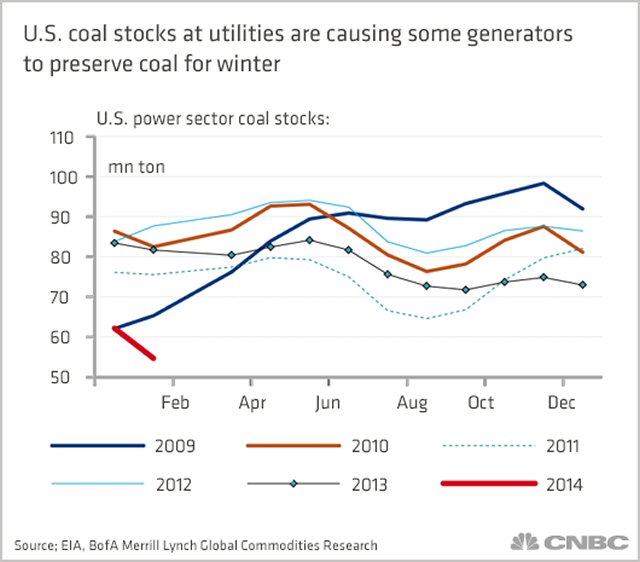What ‘war on coal’?
The carbon fuel is doing fine
Javier E. David | @TeflonGeek
CNBC.com 06/03/2014
If there’s a war on coal, someone may have forgotten to tell the primary target.
As the Environmental Protection Agency unveils new standards on cutting carbon emissions at U.S. power plants, a confluence of factors underscore how coal still remains a vital source of generating electricity.
To be sure, regulations such as the Mercury and Air Toxic Standards, plus a shift toward natural gas by utilities, has put the fuel source under pressure. Yet nearly 40 percent of U.S. electricity is currently generated by coal, with both domestic and international use on the rise—fueled in part by a winter surge in natural gas prices. In recent research, Bank of America-Merrill Lynch noted that low U.S. coal supplies coincided with volatility in natural gas, triggered by “demand rationing” in the power sector.
The rise in coal use—especially in Europe, where natural gas prices are far higher than in the U.S.—”is driven by market economics, especially with the rebound in gas prices,” said Bordoff, who noted that it’s cheaper for utilities to scale back on nat gas and use coal. Despite that, the EPA is likely to “change the economics of coal” by stiffening emissions targets for carbon intensive fuel, he added.
If there’s a war on coal, someone may have forgotten to tell the primary target.
As the Environmental Protection Agency prepares to unveil new standards on cutting carbon emissions at U.S. power plants, a confluence of factors underscore how coal still remains a vital source of generating electricity.
To be sure, regulations such as the Mercury and Air Toxic Standards, plus a shift toward natural gas by utilities, has put the fuel source under pressure. Yet nearly 40 percent of U.S. electricity is currently generated by coal, with both domestic and international use on the rise—fueled in part by a winter surge in natural gas prices. In recent research, Bank of America-Merrill Lynch noted that low U.S. coal supplies coincided with volatility in natural gas, triggered by “demand rationing” in the power sector.
Coal is a leading cause of global carbon emissions. However, in spite of predictions about its demise, demand for the fuel source is expected to rise by more than 4 percent this year, according to the Energy Information Administration.
“It’s not surprising there’s strong demand, because coal is a relatively cheap source of generating electricity when you don’t account for social costs,” said Jason Bordoff, director of Columbia University’s Center on Global Energy Policy.
The rise in coal use—especially in Europe, where natural gas prices are far higher than in the U.S.—”is driven by market economics, especially with the rebound in gas prices,” said Bordoff, who noted that it’s cheaper for utilities to scale back on nat gas and use coal. Despite that, the EPA is likely to “change the economics of coal” by stiffening emissions targets for carbon intensive fuel, he added.
The new rules come as the Obama administration is under scrutiny from conservationists. With a climate change bill stalled by foes in Congress, the carbon reduction initiative looms as a major test of President Obama’s climate bonafides.
The Union of Concerned Scientists cites coal plants as “the nation’s top source of carbon dioxide,” adding that the typical plant generates more than 3.5 million tons of greenhouse gasses per year. But the fuel is economically important for producing states like Kentucky, West Virginia and Ohio, which have fought to preserve its use.
Even before the EPA’s changes are made public, the battle over its substance has already been joined.
In a study, the U.S. Chamber of Commerce said that curbing carbon emissions could cost the economy more than $50 billion a year, and result in the elimination of 224,000 jobs. Yet the Natural Resources Defense Council did a study of its own, saying new EPA rules could actually save the country more than $37 billion on electricity bills in 2020, and create more than 274,000 jobs.
Battle between coal, natural gas
The dynamic between natural gas and coal is important as well, because gas is a linchpin of the U.S. government’s efforts to make coal obsolete. The White House hopes to push natural gas usage as a percentage of electricity generation up to 46 percent by 2030, up from its current levels near 30 percent.
Environmental regulations, the availability of coal and the price of natural gas are all determinants that utilities must weigh when deciding how to fire up plants.
“The EPA decision is part of a long-term analysis” made by the power sector, said Sue Kelly, CEO of the American Public Power Association. In an interview, she said utilities would do best “not to put too many eggs in the baskets of either coal or gas,” adding that renewable energy should also be part of power companies’ portfolio.
Coal’s continued popularity in the face of mounting challenges can be attributed to some of the baggage carried by nat gas, often cited as one of the cleanest power sources. Kelly says a dearth of pipelines in the U.S. was a big factor behind the surge that sent gas prices up more than 40 percent over the winter.
“If I were handicapping natural gas vs coal, I would put my money on nat gas in the long run,” she said. However, “with nat gas you are dependent on a pipeline delivery system, and there can be issues there.”
